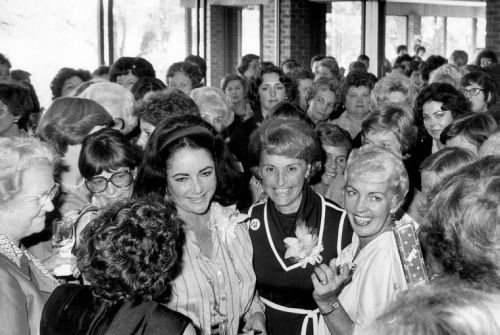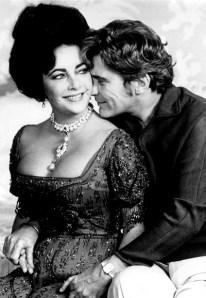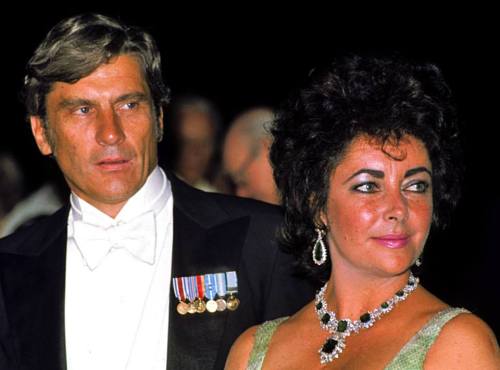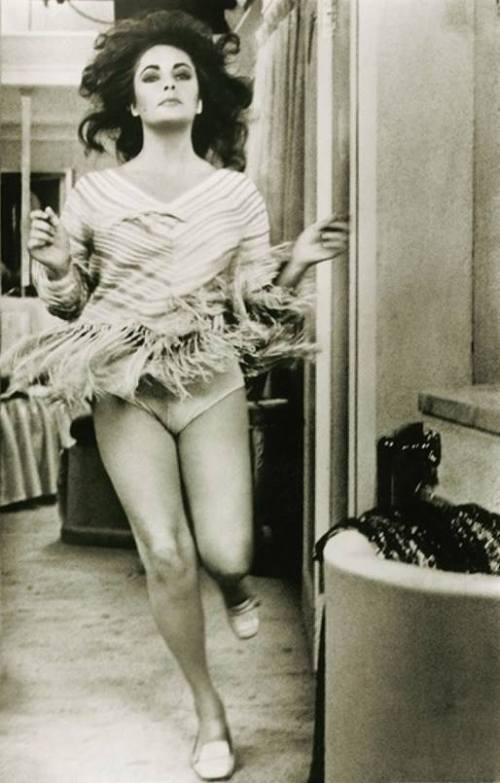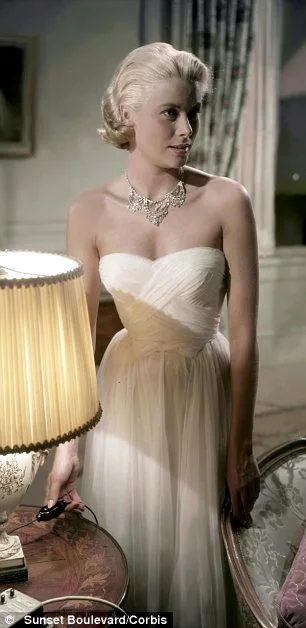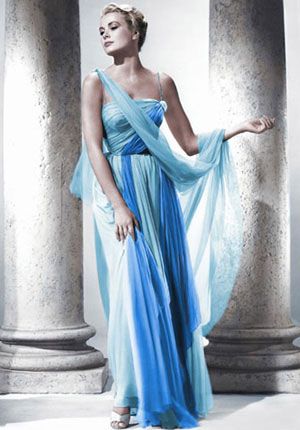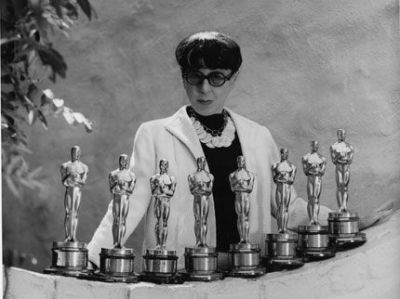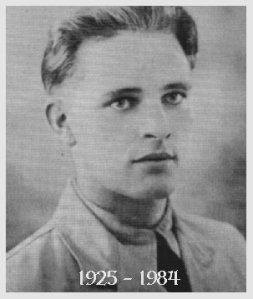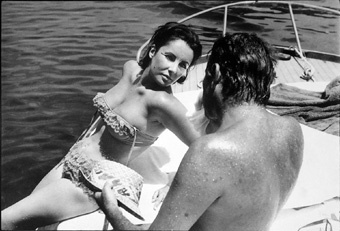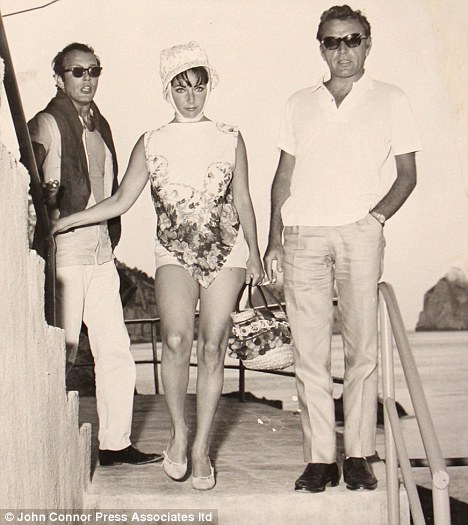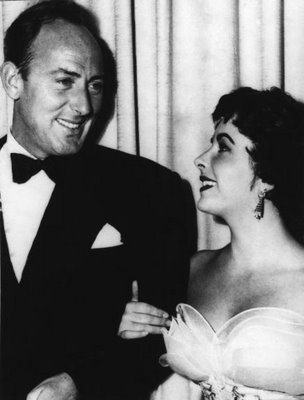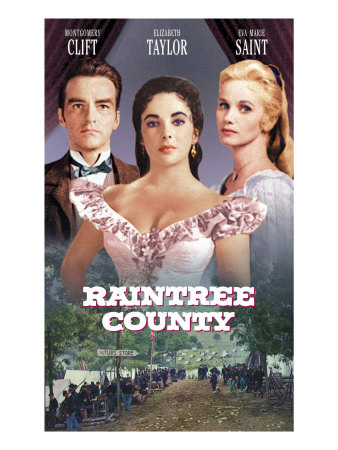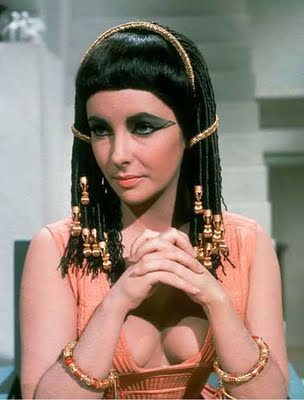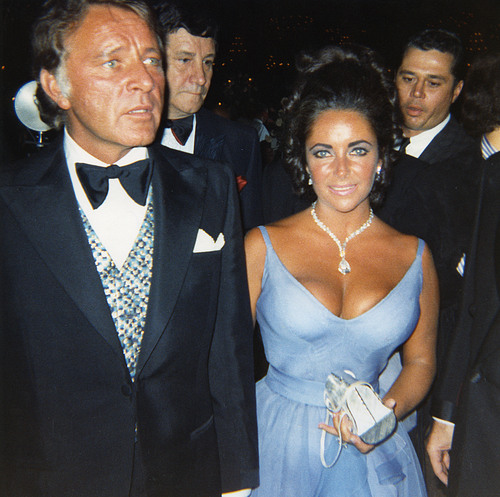Elizabeth Taylor (1932-2011) was willing to do almost anything to get her seventh husband, Virginia lawyer John Warner, elected to the U.S. Senate in 1978. To woo voters and the Republican Party leaders, Elizabeth had to prove to be an asset to the campaign. She had to make the transformation from movie queen to political wife. (Readers: For how they got together, read the previous post.)
During their brief courtship, Warner was given cause to worry that she could not make the leap. He recalled inviting Elizabeth to lunch with him in Washington, D.C.. Looking forward to showing her off, he was embarrassed when she appeared at the Bicentennial office (where he was director)
wearing a flowing black silk pajama outfit with a low-cut neckline.” (1)
Then there were her showy jewels, for example, an “eye-popping necklace of…egg-sized canary diamonds and amethysts as big as her fist.” Elizabeth promised her husband she would dress down, cutting down on the diamonds and the décolletage, opulence that would not go over big with plain Southern Virginia folk.

At a British Embassy reception, Queen Elizabeth II of England gets a look at Elizabeth Taylor’s famous jewels: the Bulgari Grand Duchess Vladimir Suite of emeralds and diamonds from her soon-to-be-ex-husband, Richard Burton. July 1976
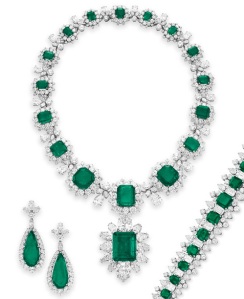
The Grand Duchess Vladimir Suite of emeralds and diamonds, once part of the Elizabeth Taylor Collection
Besides sacrificing her fashion sense, Elizabeth would set her career aside during this period, appearing in only a handful of films and, then, mostly in cameo roles, requiring only a short stint away from the campaign.
Then there were her friends of the moment, the hard-partying, cocaine-sniffing crowd of the notorious New York disco Studio 54: Liza Minnelli, fashion designer Halston, Andy Warhol, Bianca Jagger. Warner steered her away from hanging out with them at the club (although she did install a discotheque at the farm for entertaining them).

Elizabeth Taylor dances with her fashion designer friend Halston at Studio 54. Note that Elizabeth wears a purple pantsuit. Feb. 1978
Self-restraint, too, was called into play, if Elizabeth was going to help Warner hit a home run, for Elizabeth was a hot-blooded woman, prone to hard-drinking, cursing, and screaming at photographers trying to shoot her from uncomplimentary angles.
In January, 1977, weeks after returning from honeymooning in Switzerland, Elizabeth and John hit the campaign trail with an appearance at the Hearts of Gold Ball in Richmond, which they reached by Greyhound bus. From here on out, for Elizabeth, it would be a 23-month slog of kissing babies, speechifying, ribbon-cutting, riding in parades, chairing galas, raising funds, eating corn-on-the cob at county fairs, signing autographs, hurling cream pies, and pinning Warner buttons on Democrats. If a college campus had a drama department, she held a seminar for the students and allowed friendly question and answer sessions, unscripted, with no retakes, to which she was accustomed on a movie set. Toward the end of the race, she and Warner put in 12-15 hour days, riding in planes, buses, cars, and trains to reach their destinations.
Large, enthusiastic crowds turned out to see Elizabeth, accessible to them, no longer protected by bodyguards, as in her movie stardom days. She shook so many hands that, one day, two blood vessels broke in her hand. That did not slow her down. She continued to shake hands, though her hand was swollen and protected by an elastic bandage. Elizabeth’s bursitis flared up in her shoulder from such rigorous handshaking. She received cortisone injections to help with the pain. Sometimes she campaigned in a wheelchair. But she kept going. She did it because
‘They come to see my wrinkles and pimples, and I don’t disappoint them, do I?’ she laughed. ‘This face has been around a lot of years. People want to see if my eyes really are violet or bloodshot or both. Once they check me out, they can go home and say, ‘I saw Liz Taylor and you know what? She ain’t so hot!'” (1)
At almost every campaign stop, Elizabeth Taylor look-alikes would show up, in big wigs and evening gowns.
Unfortunately, a lot of the people who showed up at rallies came to see if Elizabeth was as obese as it was being reported in the press. The strain of the campaign was beginning to take its toll on her. Her weight had ballooned and she was drinking booze in excess and eating way too much. Joan Rivers was regularly lampooning her with fat jokes on “The Tonight Show“:
Every time Liz Taylor goes into McDonald’s, the numbers on the sign outside start changing. When she looks up and see five billion, she thinks it’s her weight.”
Elizabeth was affected by such cruel commentary. Nevertheless, she continued eating and drinking herself into oblivion. Dinner guests reported seeing her eat, in one sitting, mounds of mashed potatoes drowned in gravy, followed by five rich desserts and countless bottles of champagne. (2) In her defense, she remarked:
‘I am not a monument that pigeons can doo-doo on. I am a living human being, and if I want to eat fried chicken six times a day and can still function, that’s up to me!'” (1)
In August, 1978, John Warner became the Republic nominee for the U.S. Senate seat from Virginia, when the original nominee was suddenly killed.
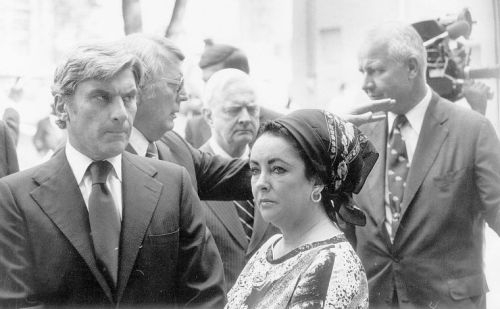
John Warner became the Republican nominee for the 1978 U.S. Senate race by a strange circumstance. Richard Obenshain was the nominee but he died in a plane crash. John Warner and wife Elizabeth Taylor are shown here at Obenshain’s funeral. Aug. 5, 1978. Photo: Don Long, Richmond Times Dispatch
The general election was on November 7; there were three months to go. The strain of the long and grueling campaign trail was apparent in both of them; tempers frayed and Elizabeth kept eating, eating, and then eating some more. Some campaign leaders worried that Elizabeth’s star appeal was overshadowing the candidate. They considered removing her from the campaign.
On October 12, 1978, three weeks before the election, Elizabeth was to suffer one of the many freak accidents for which she was known. She appeared at a rally at Big Stone Gap, Virginia. The whole countryside was in a dither to see her.
Elizabeth Taylor wore her purple silk Halston pantsuit accessorized with a sumptuous gold necklace studded with amethyst stones the size of cookies and matching drop earrings encrusted with pearls. She had tucked a small bouquet of fresh violets behind one ear. She posed for photo after photo with a smile that was genuine.

Elizabeth Taylor and John Warner, center, pose at a campaign rally in Big Stone Gap, Virginia. Oct. 12, 1978. Note the purple Halston pantsuit Elizabeth is wearing.
Later that evening, John and Elizabeth stopped for a chicken dinner at Fraley’s Coach House, where Elizabeth took a bite of a fried chicken breast and accidentally swallowed a two-and-a-half inch bone. The bone lodged in her throat. She clutched her neck, barely able to breathe. She tried to cough it up, but in vain. She stuffed some rolls into her mouth to try to push the bone down her throat but it didn’t work. It was clear that she was choking to death. (3) She was rushed to Lonesome Pine Hospital, where a thoracic surgeon inserted a rubber hose down her throat and stuffed the bone down where it dissolved in digestion. She was overnight in the hospital. The next day, she made the headlines:
‘ACTRESS NEARLY CHOKES AT CAMPAIGN RALLY,’ screamed The Washington Star.

Elizabeth Taylor is assisted from an airplane by her husband, John Warner (r.) as she returns from a hospital stay in Richmond, Va. Oct. 13, 1978
Strangely, it was about this time that a delegation of women who ran the Warner campaign chose to approach Elizabeth and inform her that she could no longer wear purple to John’s rallies. Everyone knows that purple was her signature color. Her legendary eyes were violet. In a 1997 interview with Kevin Sessums, Elizabeth recalled:
‘If the woman is the politician, then it might be quite different. But if you’re wedded to the politician, it’s like your lips are sealed. You are a robot. They even tell you what you can wear. You can imagine how that sat with me! I was told that I—me!—was not allowed to wear purple because it smacked of royalty.’
She told Harper’s Bazaar:
‘The Republican women told me, ‘You simply cannot wear the purple pantsuit you’ve been campaigning in anymore.’ I ended up in a tweed suit. Me. Little tweed suits. What I won’t do for love.'”
On November 7, John Warner squeaked to victory. Out of 1.2 million votes, he was elected to the U.S. Senate from Virginia by only 4,271 votes. He could not have done it without Elizabeth. Some say that the chicken bone incident moved the public to sympathy for her, swinging the vote in Warner’s favor. Elizabeth joked later
‘I seem to have at least 4, 271 fans in Virginia, so at least I know I pulled my own weight!'” (2)
After the election, the Republican women threw Elizabeth a luncheon in her honor, for all she had done in the campaign. In her Kevin Sessums interview, Elizabeth said she
…put on my purplest Halston pantsuit. I told them the story that the women who ran John Warner’s campaign had forbid me to wear purple. I got up and pointed out one specific woman. I said, ‘That one! Right there!'”
The subjugation of her own ego to John’s for two full years damaged Elizabeth’s self-esteem. There were few movie roles for an aging beauty, especially a puffy one. Elizabeth Taylor, movie star, had lost her self-identity.
John and Elizabeth moved to Washington, D.C., where, on January 16, 1979 in the gallery of the U.S. Senate, John was sworn in with Elizabeth and her mother in attendance. Things looked rosy for the couple at that moment. John and Elizabeth threw each other big Hollywood kisses, but John immediately became consumed by his new job, declaring he would never miss a roll call. Elizabeth was left alone for long stretches of time in their Washington home or Virginia farmhouse, consoling herself with massive quantities of Jack Daniels and chili dogs. She resorted to trips to New York to hang out at Studio 54. Elizabeth liked to have a man around and John wasn’t there for her. Whereas John may have loved Elizabeth, he loved work more.

Elizabeth Taylor, center, hangs out at Studio 54 with singer Liza Minnelli (l.) and First Lady Betty Ford (r.). 1979
Elizabeth had married John Warner in the hopes that he would give her the roots (and a private life) that she had longed for so much in her hurried life. Instead, she had spent the first two years of their marriage on the campaign trail and in the public eye more than before, if that is possible. Her life was more stressful than ever. As a star, she was used to crushingly cruel movie reviews but nothing could have been as brutal as the punishing ridicule she had received from the media for her weight gain.
Though these years were painful for Elizabeth – she and John Warner would divorce after six years of marriage – her worsening addiction to alcohol, pain pills and food would put her feet firmly on a path that led, in 1983, to a life-changing stay at the Betty Ford Clinic. A new Elizabeth Taylor would emerge from the famous rehab: a savvy and respected politician who would use her high profile celebrity to raise mega millions to combat the deadly disease, AIDS, by creating AMFAR.
(1) Kelley, Kitty. Elizabeth Taylor: The Last Star. New York: Simon & Schuster, 1981.
(2) Heymann, C. David. Liz: An Intimate Portrait of Elizabeth Taylor. New York; Simon & Schuster, 1995.
(3) Taraborrelli, J. Randy. Elizabeth. New York: Grand Central Publishing, 2006.
Readers: For more on Elizabeth Taylor, click here.





